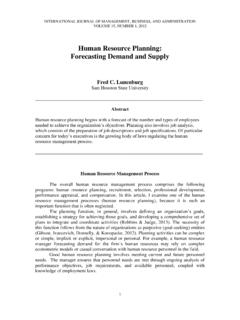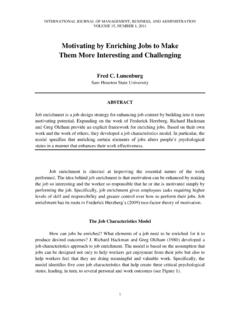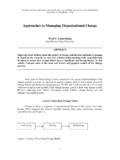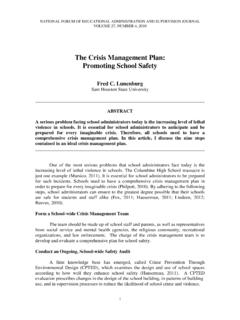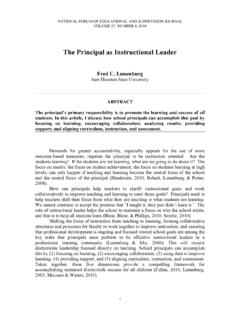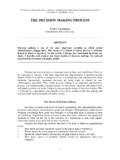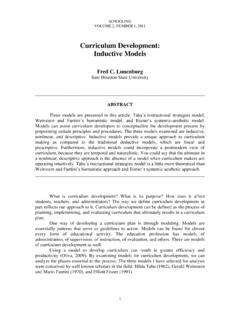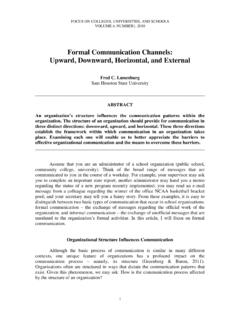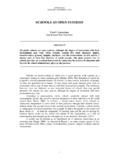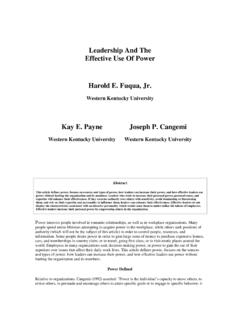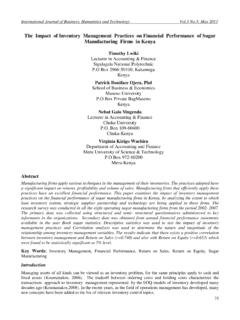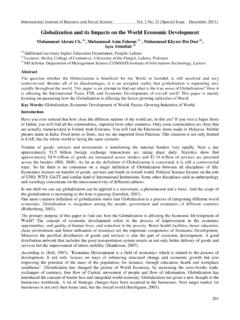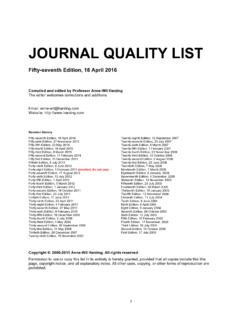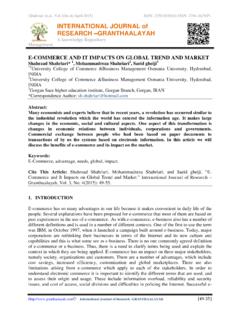Transcription of Group Decision Making: The Potential for Groupthink
1 international journal OF MANAGEMENT, business , AND ADMINISTRATION VOLUME 13, NUMBER 1, 2010 1 Group Decision making : The Potential for Groupthink Fred C. Lunenburg Sam Houston State University _____ ABSTRACT One dysfunction of highly cohesive groups that has received considerable attention is a phenomenon known as Groupthink . Essentially, Groupthink is the tendency of cohesive groups to reach consensus on issues without offering, seeking, or considering alternative viewpoints. As a result, Groupthink has been blamed for Decision making fiascoes in politics, the military, as well as in business . In this article, I discuss some famous examples of political and military fiascoes associated with Groupthink , some symptoms of Groupthink , and ways to avoid Groupthink when making Group decisions.
2 _____ Many decisions in organizations are made by groups, teams, or committees (Gunnarsson, 2010). Does that mean that Group decisions are preferable to those made by an individual? Let s begin by looking briefly at the benefits of Group Decision making (Robbins & Judge, 2011). Groups generate more complete information and knowledge. They offer increased diversity of views. Decisions made by groups lead to increased acceptance of the Decision . In spite of the benefits noted, Group decisions have their weaknesses. One dysfunction of Decision making that has received a considerable amount of attention from researchers is a phenomenon called Groupthink (Brownstein, 2003; Chapman, 2006; Choi & Kim, 1999; Eaton, 2001; Esser, 1998; Fuller & Aldag, 1998; Harvey, 1974: Hogg & Hains, 1998; Janis, 1972, 1982, 1988; Jones & Roelofsma, 2000; Kerr & Tindale, 2004; Leana, 1985; Levine, Higgins, & Choi, 2000; Longley & Pruitt, 1980; Moorhead & Montanari, 1986; Neck & Moorhead, 1995; Park, 1990, 2000; Schafer, 2011; Schultz & Bloch, 2006; Turner & Pratkanis, 1998; Whyte, 1989).
3 international journal OF MANAGEMENT, business , AND ADMINISTRATION 2_____ Groupthink Irving Janis coined the term Groupthink , which happens when in- Group pressures lead to a deterioration in mental efficiency, poor tasting of reality, and lax moral judgment (Janis, 1982). It tends to occur in highly cohesive groups in which the Group members desire for consensus becomes more important than evaluating problems and solutions realistically. Janis observed that sometimes groups of highly qualified and experienced people make very poor decisions. The Decision made by President John F. Kennedy and his advisers to launch the Bay of Pigs invasion of Cuba in 1960; the Decision made by President Lyndon B. Johnson and his advisers between 1964 and 1967 to escalate the war in Vietnam; the Decision made by President Richard M.
4 Nixon and his advisers to cover up the Watergate break-in in 1972; the Decision made by NASA in 1986 to launch the Challenger space shuttle (which exploded after takeoff, killing all seven crew members); the Decision made by NASA in 2003 to launch the space shuttle Columbia (which exploded over Texas upon reentering the earth s atmosphere, killing all seven crew members) all these decisions were influenced by Groupthink (Esser & Linoerfer, 1989; Hirokawa, Gournan, & Martz, 1988; Kerr & Tindale, 2004; Levine, Higgins, & Choi, 2000; Maier, 2002; McAvoy & Butler, 2007; Moorhead, Ference, & Neck, 1991; Schafer, 2011; Schultz & Bloch, 2006; Schwartz & Ward, 2003). Janis s analyses of Groupthink focused primarily on political and military decisions, but the Potential for Groupthink in any organization is likely as well (Finkelstein, 2003; Miller, 1990; Tasa & Whyte, 2005).
5 For example, when a Group of employees collectively decides to go on strike, the Decision may be a product of Groupthink (Carrell, 2010). Symptoms of Groupthink Janis identified eight symptoms of Groupthink : Invulnerability. Most or all Group members develop an illusion of invulnerability, which causes them to become overly optimistic and take extreme risks. Rationalization. Group members collectively rationalize in order to discount warnings that might lead them to reconcile their assumptions before they commit themselves to their past policy decisions. Morality. Group members develop an unquestioned belief in the Group s inherent morality, inclining the members to ignore ethical or moral consequences of their decisions. FRED C. LUNENBURG _____3 Stereotyping. Group members develop stereotyped views of opposition leaders as too evil to warrant genuine attempts to negotiate or as too weak and stupid to counter whatever risky attempts are made to defeat their purposes.
6 Pressure. Group members apply direct pressure on any member who expresses strong arguments against any of the Group s stereotypes, illusions, or commitments, making clear that this type of dissent is contrary to what is expected of all loyal members. Self-Censorship. Group members censor themselves from any deviations from the apparent Group consensus, reflecting each member s inclination to minimize the importance of his or her doubts and counterarguments. Unanimity. Group members perceive a shared illusion of unanimity concerning judgments conforming to the majority view (partly resulting from self-censorship of deviations, augmented by the false assumption that silence means consent). Mindguards. Some Group members appoint themselves to protect the Group from adverse information that might shatter their shared complacency about the effectiveness and morality of their Decision .
7 The likelihood that Groupthink will emerge is greatest when: (a) the Group is cohesive (b) the Group becomes insulated from qualified outsiders, and (c) the leader promotes his own favored solution (Janis, 1982). In suggesting ways of avoiding Groupthink , Janis hopes to reduce cohesiveness and open up Decision activity in various ways. One way is to select ad hoc groups to solve problems; in this way, the members do not already belong to a cohesive Group . Another approach is to have higher-level administrators set the parameters of the Decision . Still another method is to assign different groups to work on the same problem. And, finally, different Group Decision - making techniques can be used to limit the effects of Groupthink and other problems inherent in shared Decision making .
8 How to Avoid Groupthink Nine suggestions for avoiding Groupthink are the following (Janis, 1982): international journal OF MANAGEMENT, business , AND ADMINISTRATION 4_____ 1. The leader of a policy-forming Group should assign the role of critical evaluator to each member, encouraging the Group to give high priority to airing objections and doubts. 2. The leaders in an organization s hierarchy, when assigning a policy-planning mission to a Group , should be impartial instead of stating their preferences and expectations at the outset. 3. The organization should routinely follow the administrative practice of setting up several independent policy-planning and evaluation groups to work on the same policy question, each carrying out its deliberations under a different leader. 4. Through the period when the feasibility and effectiveness of policy alternatives are being surveyed, the policy- making Group should from time to time divide into two or more subgroups to meet separately, under different chairpersons, and then come together to reconcile their differences.
9 5. Each member of the policy- making Group should periodically discuss the Group s deliberations with trusted associates in her own unit of the organization and report their transactions back to the Group . 6. One or more outside experts or qualified colleagues within the organization who are not core members of the policy- making Group should be invited to each meeting on a staggered basis and should be encouraged to challenge the views of the cores members. 7. At each meeting devoted to evaluating policy alternatives, at least one member should be assigned the role of devil s advocate, expressing as many objections to each policy alternative as possible. 8. Whenever the policy issue involves relations with a rival organization, a sizable block of time should be spent surveying all warning signals from the rivals and constructing alternative scenarios of the rivals intentions.
10 9. After reaching a preliminary consensus about what seems to be the best policy alternative, the policy- making Group should hold a second-chance meeting at which the members are expected to express as vividly as they can all their residual doubts and to rethink the entire issue before making a definitive choice. Conclusion One dysfunction of highly cohesive groups that has received considerable attention is a phenomenon known as Groupthink . Essentially, Groupthink is the tendency of cohesive groups to reach consensus on issues without offering, seeking, or considering alternative viewpoints. As a result, Groupthink has been blamed for Decision making fiascoes in politics, the military, as well as in business . Several examples of these political and military fiascoes have been discussed in this article.
